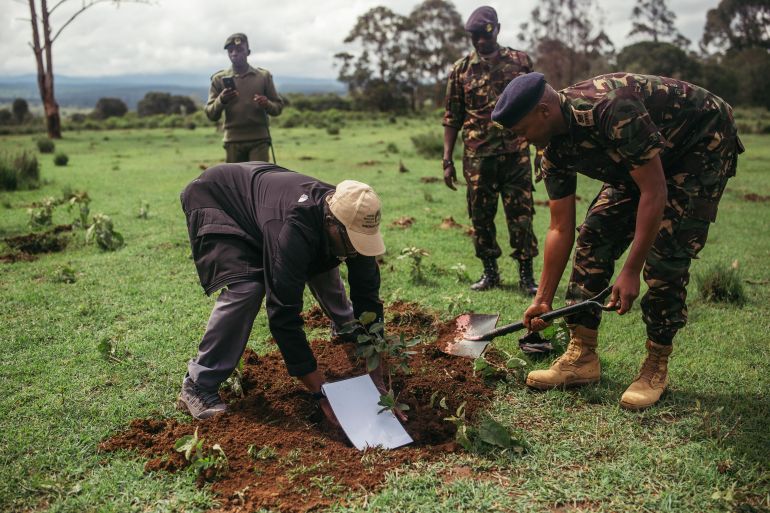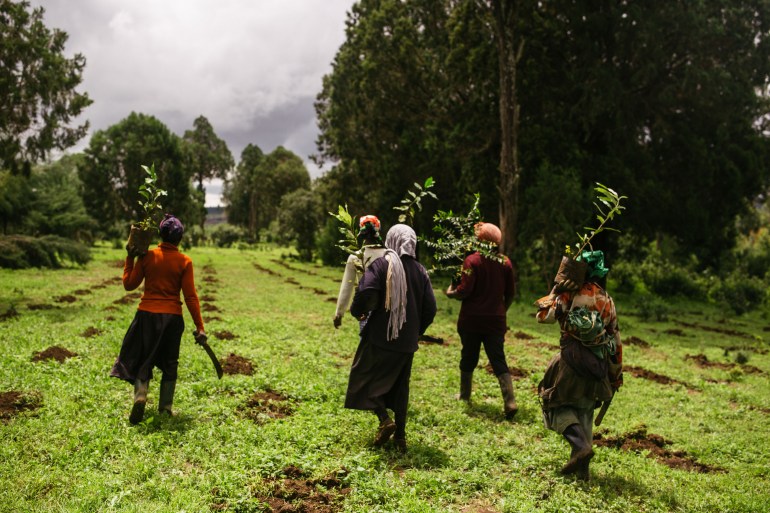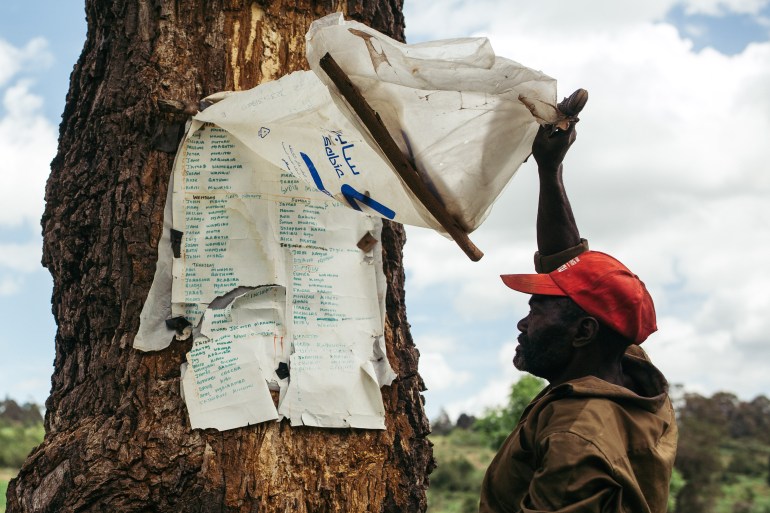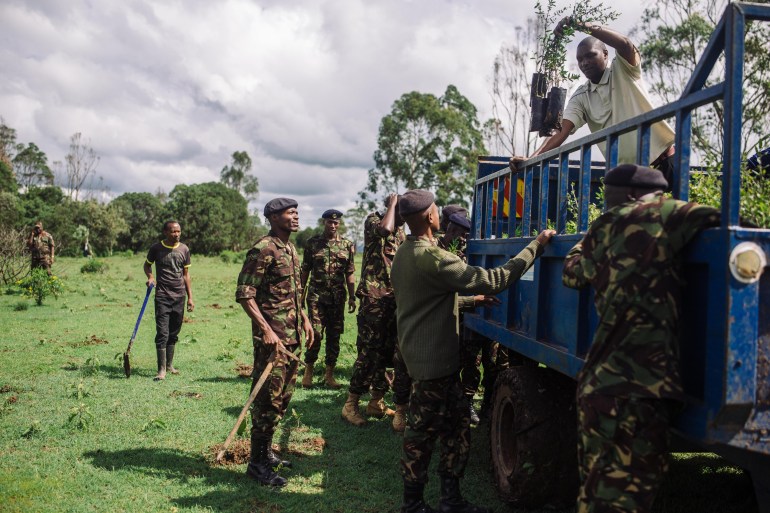Drought and conflict are hurting Kenyan forests. Can the army fix things?
Five seasons of drought and clashes caused by competition for scarce resources with nomadic herders have destroyed Kenya’s forests on a large scale.

Nyeri, Kenya – This March, rains returned to the Horn of Africa after 1,000 days of one of its most punishing droughts in four decades.
In Nyeri, just west of the Mount Kenya region, once expansive forests are drinking up the rains as fog hugs the high-altitude landscape like a familiar blanket. But much of the forests have been stripped of their former glory.
Keep reading
list of 4 itemsAustin confirms Russians deployed to airbase housing US military in Niger
US acknowledges Syria air strike killed farmer rather than al-Qaeda leader
Russia-Ukraine war: List of key events, day 798
Decades of poor management by the Kenya Forest Service, the state agency tasked with managing forests and increasing forest cover, allowed large-scale logging and rampant firewood collection.
The impact has been severe. From 2002 to 2022, Global Forest Watch estimated that Kenya lost more than 50,000 hectares (193 sq miles) of primary forest or 14 percent of its tree cover.
At the peak of the drought, thousands of pastoralists from tribes such as the Samburu, Sakuye, Rendille, and Marakwet flocked from the more arid counties of Samburu and Laikipia to Nyeri. They made a beeline to what greenery was left in Mount Kenya National Park and Reserve, hundreds of kilometres away.
By doing so, these nomadic herders encroached on the Meru and Kikuyu communities’ land in high-altitude central Kenya to give their animals a chance to survive.
The park, a UNESCO world heritage site, is home to Africa’s second-highest peak and is 60km (40 miles) southeast of Nanyuki, one of Laikipia’s biggest market towns. Born of an extinct volcano, the fragile afro-alpine terrain grows lichen, tussocky grasses, and moss, which is hardly prime grazing land.

Tensions over land use
With the herders came violence too as they tussled for declining resources.
Before the drought, 50-year-old John Guthungu Mwangi had 35 head of cattle in Gaithuru, a western region of the Mount Kenya National Reserve, but they dwindled to a dozen. It was difficult sharing what little grass his community had with outsiders, he said.
“They wouldn’t always respect our land,” he told Al Jazeera. “Some even stole our animals as they were leaving.”
Five back-to-back seasons of no rain have exacerbated stress over forest resources, said Emma Odera, a research scientist at the Nanyuki-based Centre for Training and Integrated Research for ASAL (arid and semi-arid landscapes) Development.
“Migratory corridors that connect the forest ecosystem with other landscapes face higher tensions over land use,” she told Al Jazeera. “There are already tensions over land use and encroachment, … but these conditions are making it that much worse.”
Over the past five years, there have been rising incidences of conflicts within local communities throughout Kenya, notably in Laikipia, just north of Nyeri, and neighbouring pastoral counties, including Isiolo, Samburu, Baringo and Meru, all volatile areas in their own right.
According to the Armed Conflict Location and Event Data Project, pastoral violence constituted nearly a third of all political violence in the first quarter of 2023, resulting in at least 73 recorded casualties.
Although most roving herders have left Mount Kenya’s forests since the rains have returned, the damage wrought – erosion, trampling, tree cutting for construction of temporary corrals and shelters – remains.
Kenyan researchers have long identified insufficient water and pasture for animals as well as unchecked small-arms trafficking across porous borders to Uganda, Ethiopia, and South Sudan as some of the factors intensifying communal clashes. National and county governments have also been accused of failing to address these root causes.
“It comes down to a highly political situation,” said Susie Weeks, executive director of the Mount Kenya Trust, an organisation that partners with the government and communities for sustainable resource management.
Weeks says politicians or other powerful individuals funnel funds into cattle as a means of laundering money and hire young men for a pittance to watch over their animals. This relatively recent commercialisation of pastoralism breaks age-old bonds born of traditional values, in which livestock signals social status and serves as a means to marry. For mercenary herders, the incentive to respect community boundaries is slim to none.
“You have people who come in and say, ‘Don’t mess with my cattle or else,’” Weeks said.
There is licensing that certain forest stations around the Mount Kenya region have to manage grazing numbers – herders pay a small monthly fee (116 shillings, or $0.82, per month per head of cattle and 80 shillings, or $0.57 per month for each sheep). But enforcement remains lax due to a lack of manpower and possibly nefarious forces backing mercenary herders.
In the past, it was easier to ignore desperate small-scale herders turning up with a handful of cattle. But according to Weeks, during the drought years, they’ve been encroaching by the thousands and setting up pens in what the national government has demarcated as protected areas.
“Until the whole mountain is fenced, people will get in,” Weeks said.

Section head
Given the complexities surrounding resource scarcity and how militarised interventions have previously worsened the conflict, Kenya’s military is trying a more holistic approach.
Kenya’s military is embarking on a tree-planting spree to counter Mount Kenya’s present state of degradation and partnering with grassroots nonprofits to renew forest cover.
“We want to transform our humble environment into something that everyone can respect,” Joel Maiyo, deputy commander of the 4th Brigade based in Nanyuki, said at a tree-planting exercise.
In late May, Maiyo’s brigade of nearly 100 soldiers gathered on a cool morning in a section of the forest named Gathiuru and planted thousands of seedlings, including strangler figs, African pencil trees and muthiga trees. The military has planted an estimated 46,000 seedlings across Laikipia so far in 2023.

In 2008, former President Moi Kibaki launched Kenya Vision 2030, a developmental blueprint to industrialise the nation into a middle-income country. Part of the directive is planting 15 billion trees to make the ecosystem better and create jobs for young people, Maiyo said.
“We’re seeing rains now. This can’t happen without trees,” he told Al Jazeera. “We even see many animals come because of the forest cover. We want to see the same activities taking place back at the barracks.”
At its Nanyuki barracks, the military has five nurseries on 600 hectares (1,500 acres) of unfenced land. The environmental programme at the barracks has also established communal agricultural plots that locals can use to farm in exchange for helping with the military’s nurseries.
More than 100 people farm on the land, according to Moira Chepakiror, an environmental coordinator for the military. She estimated that the survival rate for tree seedlings is about 33 percent and said the military is working to improve that number.
“People will tell you [Nanyuki] was very good for crops and animals,” she told Al Jazeera. “The river used to be much higher.”
Environmental officers in the military also said they have enlisted local scouts to help record illicit logging and monitor conflict within their communities. Rather than just relying on rain, the military is also digging boreholes and providing water tanks to communities, especially at the conflict-prone borders, they said.
“When you go back to [understand] these conflicts, the roots are in environmental change and resource scarcity,” Chepakiror said. “Communities here don’t have reliable sources of livelihood any more. We’re trying to help establish that.”
Mwangi is grateful to the military for stepping in to offer a hand but isn’t putting much hope in the project. “Us from Gaithuru, we’re glad they’re planting trees to counter the degradation,” he said but shrugged. “No one will be surprised when things get heated again.”